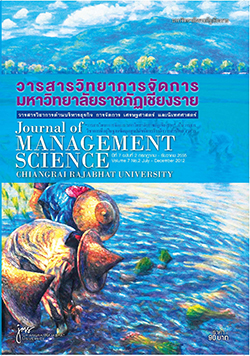A Study of Costs and Profits of Agriculturists’ Pineapple Plantation in Ban Du Sub-District, Muang District, Chiangrai Province
Main Article Content
Abstract
The purposes of this study aimed to investigate costs and profits of agriculturists’ pineapple plantation in Ban Du Sub-District, Muang District, Chiangrai Province, as well as problems and solutions of the agriculturists’ pineapple plantation in Ban Du Sub-District, Muang District, Chiangrai Province. For data gathering, questionnaires were filled in by 16 respondents, who planted their pineapples in Ban Du Sub-District, Muang District, Chiangrai Province. The data used for accounting were statistically analyzed via the use of frequency distribution and percentage. The findings of the study revealed that the total cost of pineapple plantation per rai was commonly found at 10,073.06 baht. In the 1st case study, the lowest cost of pineapple plantation per rai, in agriculturist-own land, was 9,792.84 baht. As a result, agriculturists’ profits from pineapple plantation at the highest average total profit of 15,659.35 baht was generated from 1,071.42 kilograms of the highest average total produce per rai, and therefore, the highest net profit obtained. The highest return on asset was found in the 2nd case study. In terms of the highest break even, it was stated in the 3rd case study, partially leased land. While the highest return of investment on pineapple plantation was shown in the 1st case study, agriculturist-own land. However, the first top 3 problems faced by agriculturists are the lack of rain, increasingly expensive fertilizer price which caused the deterioration of soil quality, and the lack of buyers during harvest season which resulted in dumping price. The suggested solutions for pineapple agriculturists were an education and support in pineapple plantation and organic fertilization, provided by governmental organizations. Secondly, the governmental organizations should provide additional numbers of buyers during harvest season. Finally, the governmental organizations should educate agriculturists how to improve soil quality.
Article Details
Views and opinions expressed in the journal do not necessarily reflect those of the editors.


